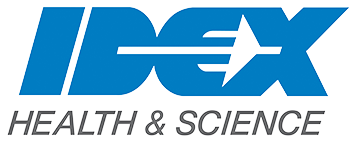Finding the Right Dichroic Beamsplitter

IDEX Health & Science makes a wide variety of 45º dichroic beamsplitters optimized for different purposes. Every dichroic utilizes our advanced hard, ion-beam-sputtered coating technology for exceptional environmental and handling durability and no degradation even under the most intense illumination conditions. The dichroics are broadly categorized by the light source with which they are intended to be used and the spectral edge steepness and physical flatness values required for various applications.
Learn more about Dichroic Beamsplitters here:
- Choosing Dichroic Beamsplitters with Flatness/RWE Appropriate to the Microscopy Method
- Flatness of Dichroic Beamsplitters Affects Focus and Image Quality
The table below lists six broad families of Semrock dichroic beamsplitters according to these requirements.
Selection Guide
| Light Source | Edge Steepness | Flatness / RWE Classification | Family | Product Page |
| Broadband | Standard | Standard Epi-fluorescence | General Purpose Dichroics | Click Here |
| Broadband | Standard | Image-splitting | Image-splitting Dichroics | Click Here |
| Laser lines | Steep | Laser | Laser Dichroics | Click Here |
| Laser lines | Steep | Super-resolution / TIRF | Super-resolution / TIRF Dichroics | |
| Laser lines | Standard | Laser | Laser Notch Dichroics | Click Here |
| Laser lines | Standard | Laser | Laser Beam Combining | Click Here |
| Laser lines | Standard | Super-resolution / TIRF | Multiphoton Laser Beam Combining | Click Here |
| Laser lines; Multiphoton | Steep | Super-resolution / TIRF | Multiedge Multiphoton Super-res / TIRF Dichroic | Click Here |
| Precise laser lines | Ultrasteep | Laser | Ultrasteep Laser Dichroics | Click Here |
Dichroic beamsplitters designed to be used with broadband light sources generally ensure the highest average value of reflection over a band of source wavelengths often chosen for best overlap with a particular fluorophore absorption spectrum. Dichroics for laser light sources ensure high absolute reflection performance at specified laser lines, with precise spectral edges that are keyed to these lines and anti-reflection (AR) coatings on the filter backsides to minimize any coherent interference artifacts.
While all Semrock dichroics are among the steepest available 45º edge filters on the market, those optimized for laser-based epifluorescence and Raman applications are exceptionally steep to enable signal collection as close as possible to the laser line.
Flatter dichroic beamsplitters minimize wavefront errors that can result in defocus and imaging aberrations of the light reflected off these filters. Semrock classifies dichroic beamsplitters into four categories of flatness, as listed in the table below.
NOTE: Mounting can impact flatness performance. Values below apply to unmounted parts.
